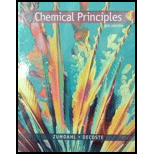
Concept explainers
Interpretation: The mole fraction of
Concept Introduction: The mole fraction of
The partial density of a compound is determined by the formula:
The formula relating partial density and total density is:
Answer to Problem 160CP
The mole fraction of
Explanation of Solution
Given:
Equimolar mixture of gases,
The density of mixture at STP is
The partial density of each gas,
Molar mass of
Let
Now, using the relation,
Substituting the values:
Substituting the value of
Hence, the mole fraction of
Interpretation: The density of gas mixture after the completion of reaction needs to be determined.
Concept Introduction: The mole fraction of
The partial density of a compound is determined by the formula:
The formula relating partial density and total density is:
Answer to Problem 160CP
The density of gas mixture after the completion of reaction is
Explanation of Solution
Given:
The
The balanced reaction for the formation of
From the balanced reaction, it can be observed that 1 mole of
Now, determining the limiting reagent:
Since, from part (a) the initial moles of the reactants are
Thus,
The density of the gas mixture is calculated using formula:
The partial density of
Molar mass of
Substituting the values:
Calculating the mole fraction of each component as:
The sum of total final moles is:
Now, the mole fraction of each component is calculated using formula:
So:
Substituting the values in equation (1):
Hence, the density of gas mixture after the completion of reaction is
Want to see more full solutions like this?
Chapter 5 Solutions
CHEM.PRINC.W/OWL2+REBATE+2 SUPPL.>IP<
- A collapsed balloon is filled with He to a volume of 12.5 L at a pressure of 1.00 atm. Oxygen, O2, is then added so that the final volume of the balloon is 26 L with a total pressure of 1.00 atm. The temperature, which remains constant throughout, is 21.5 C. (a) What mass of He does the balloon contain? (b) What is the final partial pressure of He in the balloon? (c) What is the partial pressure of O2 in the balloon? (d) What is the mole fraction of each gas?arrow_forwardThe following figure shows three 1.00-L bulbs connected by valves. Each bulb contains argon gas with amounts proportional to the number of circles pictorially represented in the chamber. All three bulbs are maintained at the same temperature. Unless stated otherwise, assume that the valves connecting the bulbs are closed and seal the gases in their respective chambers. Assume also that the volume between each bulb is negligible. (a) Which bulb has the highest pressure? (b) If the pressure in bulb A is 0.500 atm, what is the pressure in bulb C? (c) If the pressure in bulb A is 0.500 atm, what is the total pressure? (d) If the pressure in bulb A is 0.500 arm, and the valve between bulbs A and B is opened, redraw the figure shown above to accurately represent the gas atoms in all three bulbs. What is P A+P B+P C? Compare your answer in part (d) to that in part (c). (e) Follow the instructions of part (d) but now open only the valve between bulbs B and C.arrow_forwardA sample of a smoke stack emission was collected into a 1.25-L tank at 752 mm Hg and analyzed. The analysis showed 92% CO2, 3.6% NO, 1.2% SO2, and 4.1% H2O by mass. What is the partial pressure exerted by each gas?arrow_forward

 ChemistryChemistryISBN:9781305957404Author:Steven S. Zumdahl, Susan A. Zumdahl, Donald J. DeCostePublisher:Cengage Learning
ChemistryChemistryISBN:9781305957404Author:Steven S. Zumdahl, Susan A. Zumdahl, Donald J. DeCostePublisher:Cengage Learning Chemistry: An Atoms First ApproachChemistryISBN:9781305079243Author:Steven S. Zumdahl, Susan A. ZumdahlPublisher:Cengage Learning
Chemistry: An Atoms First ApproachChemistryISBN:9781305079243Author:Steven S. Zumdahl, Susan A. ZumdahlPublisher:Cengage Learning Chemistry & Chemical ReactivityChemistryISBN:9781337399074Author:John C. Kotz, Paul M. Treichel, John Townsend, David TreichelPublisher:Cengage Learning
Chemistry & Chemical ReactivityChemistryISBN:9781337399074Author:John C. Kotz, Paul M. Treichel, John Townsend, David TreichelPublisher:Cengage Learning Chemistry & Chemical ReactivityChemistryISBN:9781133949640Author:John C. Kotz, Paul M. Treichel, John Townsend, David TreichelPublisher:Cengage Learning
Chemistry & Chemical ReactivityChemistryISBN:9781133949640Author:John C. Kotz, Paul M. Treichel, John Townsend, David TreichelPublisher:Cengage Learning Chemistry: Principles and PracticeChemistryISBN:9780534420123Author:Daniel L. Reger, Scott R. Goode, David W. Ball, Edward MercerPublisher:Cengage Learning
Chemistry: Principles and PracticeChemistryISBN:9780534420123Author:Daniel L. Reger, Scott R. Goode, David W. Ball, Edward MercerPublisher:Cengage Learning





